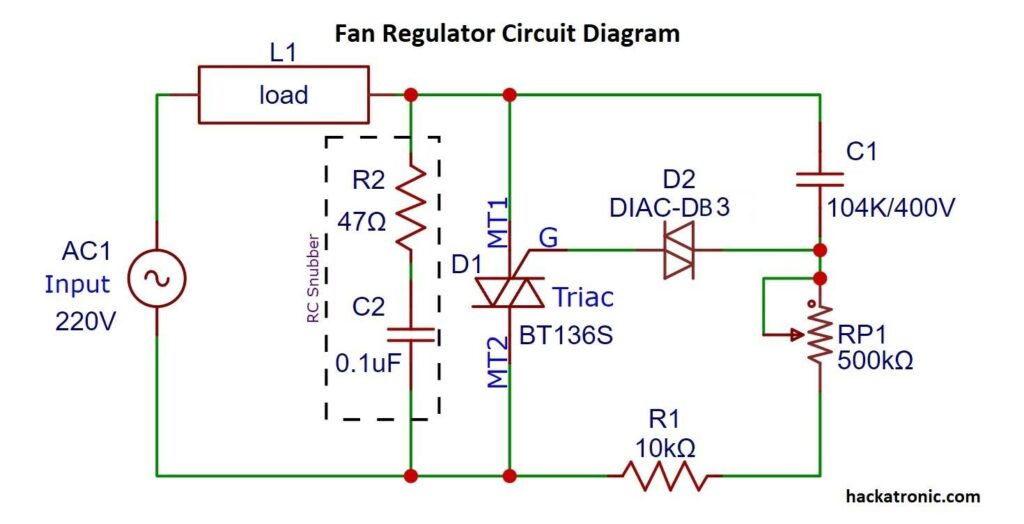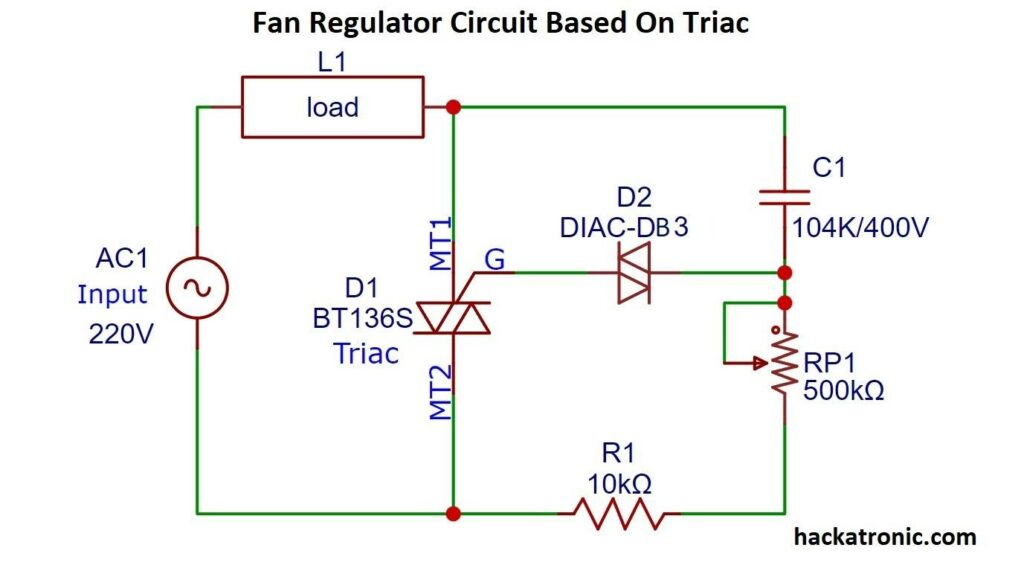In this article, you will Know about three different types of the fan regulator circuit diagram. The first one is resistor based, the second one is triac based and the third one is capacitor-based.
You must have seen those conventional old and big resistive fan regulators. Those conventional regulators use resistive wires connected between load and source. There are multiple points between wires to connect, each point offers a particular resistance. The speed of the fan is controlled by switching the tap points. Here the speed is directly proportional to the resistance of the wire.
The main advantage is that they are highly durable and do not produce any humming noise at low speeds. In these regulators nichrome wire is used as resistive material thus a lot of power is wasted due to heat produced from these wires. At low speeds, they consume almost the same amount of power at high speed.
We need a small lightweight and energy-efficient regulator. We have mainly two types of electronic fan regulators first one is a triac based and the second one is capacitor-based.
ESP32 Home Automation Project by Google Assistant & Blynk
A) Triac and Diac Based Fan Regulator Circuit Diagram:
In this triac based fan regulator circuit, you need four main components i.e. capacitor, resistor, Diac, and Triac itself. A triac is a semiconductor device it belongs to the family of thyristors, it is a PNPN type device. A triac manly works as an AC switch and a solid-state relay. Its switching frequency is 400Hz which is sufficient for this purpose.
Working and VI Characteristics of Triac
Components Required For Triac Based Fan Regulator Circuit:
- X-rated Capacitor 104K/400V
- Potentiometer 500kΩ
- Resistor R1 10KΩ
- Resistor R2 47Ω
- Capacitor C2 0.1uF
- Triac BT136
- Diac DB3
Fan Regulator Circuit Explanation:
The triac based regulator circuit is present between load and source. As you can see in the circuit diagram diac connects to the gate of the triac. A potentiometer and a capacitor are connected to the other terminal of the diac. This RC circuit provides an RC time constant for the diac to turn ON and OFF. A 10KΩ resistor is in series with a 500KΩ variable resistor.
An RC snubber circuit must be connected in parallel with the Triac BT136. RC snubber circuit contains a resistor connected in series with a capacitor. RC snubber circuit is used to protect triac from any high voltage spikes and back EMF produced from inductive loads like fan or motor. Use this circuit with inductive load, it is not necessary with a resistive load.

Working Of Triac Based Fan Regulator:
Diac is a bidirectional device it has two diodes in opposite directions. Our Triac is also a bidirectional device it can conduct in both directions.
When the supply turns on the triac is in OFF state, the capacitor C1 starts charging from load and resistor. Eventually, the voltage of the capacitor becomes more than the break over voltage of diac( break over voltage of diac is around 32V), the diac turns on and it switches the triac. This is how the triac turns on and completes the circuit for the load. After this, the capacitor starts to discharge and the voltage across diac DB3 starts decreasing. When the voltage across diac becomes less than the breakover voltage diac becomes OFF and switches the triac to OFF state. This turn ON and OFF occurs very rapidly depending on the RC time constant.
The charging and discharging of capacitors occur randomly and also switching of triac is random. The RC time constant of resistor and capacitor can be increased by increasing the value of the resistor. When the resistance is high the triac is ON for a very less interval of time hence a very small amount of current flows through it and speed of the fan becomes slow.
The main advantage of this circuit is that it is very cheap, small in size, and power-efficient. But here is a disadvantage that at low speeds FAN produces a humming noise.
Capacitor Based Fan Regulator:
Now we will see a noiseless capacitor-based fan regulator circuit,
You can see in the circuit diagram that there are several capacitors in series with a 2.2Ω resistor and parallel with a 220KΩ resistor connected to a rotary switch. Each capacitor has a different value of capacitance to provide a different value of reactance in the circuit. You can avoid using 2.2Ω resistor.
Working of Capacitor Based Fan Regulator:
When a non-polar capacitor in series with a resistor is provided with an AC supply it can give a constant current. Here the reactance of the capacitor must be more than the value of the resistor. Current flowing through the 2.2Ω resistor depends on the value of the capacitor. Current flowing through the capacitor is given by
Irms = Vin/X
Vin is the input AC voltage and X is the reactance of capacitor it is given by,
X = 1/2ΠFC
For example impedance of 1uF capacitor at 50Hz is 3183.09Ω and the current flowing through capacitor V/X is 0.07225A.
The 220KΩ resistor in parallel with the capacitor is a bleeder resistor. It protects by removing the current stored in the capacitor when the mains supply goes OFF. It prevents any shock hazards because when it is fully charge the capacitor stores around 400V.
Capacitor-based regulators are very popular, easily available, cheap, and power-efficient. They are costly than triac based regulators but their output is a very smooth pure sine wave. The main advantage of these regulators over triac based regulators is that FANs do not produce humming noise at low speeds.
I hope you understood how a fan regulator works if you have any doubts comment down.




Hello !
I’ve realized the circuit and it seems to almost work.
Only problem I have it burns the 2.2K resistor on the 2.2uf and 3.3uf capacitors ( medium/high speed ).
No problem on the 1uf capacitor ( slowest speed ).
Do you know why ?
Thanks for your infos
What is the power rating of resistor? Try changing high power value resistor
The resistor have a wattage of 0,5W but I didn’t expected to have a more power dissipation.
Can I ask you why you choose to have 2.2K ohm ? On other circuit I found no resistor or at least 2.2ohm which obviously have a lower resistance, thus lower power dissipation.
Thanks again.
Is that 1/2-watt resistor?
I added 2.2kΩ resistor to limit current but since it is causing problem you can avoid using it.
Thank You
Yes, is a 1/2W resistor.
How much should it be, in your opinion ?
Thanks
I have Updated the circuit you can check.
The whole purpose of this circuit is to add some Impedance
Is there one more method for regulating AC fan speed is by an auto-transformer?
No not recommend
why it is not recommended
The above circuits are useful in small ceiling fans (up to 100W–200W).
Auto transformers are useful in Large or industrial fans and HVAC systems.